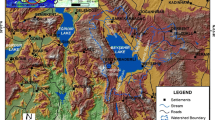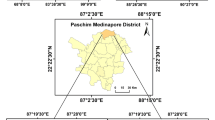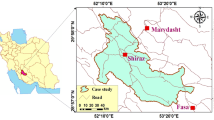Abstract
The efficient management and the sustainability of groundwater resources in mining areas require the accurate identification of groundwater resources. Identification and prediction of water resources in mining areas should be done in the design and planning stage of mining so that mining operations are carried out in a dry environment and the groundwater resources face the least damage. Hence, this study aims to identify groundwater resources in the western anomalies of Sangan iron mine using the Fuzzy Analytic Hierarchy Process (FAHP), fuzzy overlay, Dempster-Shafer and Coupled-Groundwater Potential Mapping method (C-GPM) techniques in GIS software. The geology, surface hydraulic conductivity, drainage density, slope, aspect, topography, lineament density, vegetation and alteration layers play an important role to delineate and assess groundwater potential map in the study area. After classifying the maps and weighting of each layer based on the quantitative assessment scores by hydrologists, hydrogeologists, geologists, environmental and mining experts, the potential map of groundwater resources in the study area was prepared by each of the above techniques. Finally, in order to validate the results, the groundwater potential map obtained from each of the above four methods was compared to the water level map of the study area. By examining the values of statistical parameters to evaluate the error related to the four techniques, it was determined that the groundwater potential map obtained by the C-GPM method showed less error, so it can be concluded that C-GPM method can be used as a fast and reliable approach to model groundwater potential for the proper management of groundwater resources, and the implemented method can be used in other similar conditions.






















Similar content being viewed by others
Data availability
The data that support the findings of this study are available from the corresponding author upon reasonable request.
References
Abu El-Magd SA, Embaby A (2021) To investigate groundwater potentiality, a GIS-based model was integrated with Remote Sens data in the Northwest Gulf of Suez (Egypt). Arab J Geosci 14(24):1–12. https://doi.org/10.1007/s12517-021-08396-2
Ahmadi H, Pekkan E (2021) Fault-based geological lineaments extraction using remote sensing and GIS—a review. Geosciences 11(5):183. https://doi.org/10.3390/geosciences11050183
An P, Moon WM, Rencz A (1991) Application of fuzzy set theory for integration of geological, geophysical and Remote Sens data. Can J Explor Geophys 27(1):1–11
Benjmel K, Amraoui F, Aydda A, Tahiri A, Yousif M, Pradhan B, ... Abioui M (2022) A multidisciplinary approach for groundwater potential mapping in a fractured semi-arid terrain (Kerdous Inlier, Western Anti-Atlas, Morocco). Water 14(10):1553. https://doi.org/10.3390/w14101553
Bera A, Mukhopadhyay BP, Barua S (2020) Delineation of groundwater potential zones in Karha river basin, Maharashtra, India, using AHP and geospatial techniques. Arab J Geosci 13(15):1–21. https://doi.org/10.1007/s12517-020-05702-2
Beucher A, Fröjdö S, Österholm P, Martinkauppi A, Edén P (2014) Fuzzy logic for acid sulfate soil mapping: application to the southern part of the Finnish coastal areas. Geoderma 226:21–30. https://doi.org/10.1016/j.geoderma.2014.03.004
Bezerra EDC, Teles AS, Coutinho LR, da Silva e Silva FJ (2021) Dempster–Shafer theory for modeling and treating uncertainty in IoT applications based on complex event processing. Sensors 21(5):1863. https://doi.org/10.3390/s21051863
Bhadran A, Girishbai D, Jesiya NP, Gopinath G, Krishnan RG, Vijesh VK (2022) A GIS based fuzzy-AHP for delineating groundwater potential zones in tropical river basin, southern part of India. GeoGeo 1(4):100093. https://doi.org/10.1016/j.geogeo.2022.100093
Bien TX, Jaafari A, Van Phong T, Trinh PT, Pham BT (2023) Groundwater potential mapping in the Central Highlands of Vietnam using spatially explicit machine learning. Earth Sci Inform. 16:131–146. https://doi.org/10.1007/s12145-022-00925-1
Bonham-Carter G (1994) Geographic information systems for geoscientists: modelling with GIS. Pergamon Press, New York
Burnett BN, Meyer GA, McFadden LD (2008) Aspect-related microclimatic influences on slope forms and processes, northeastern Arizona. J Geophys Res Earth Surf. https://doi.org/10.1029/2007JF000789
Carranza EJM, Woldai T, Chikambwe EM (2005) Application of data-driven evidential belief functions to prospectivity mapping for aquamarine-bearing pegmatites, Lundazi district Zambia. Nat Resour Res 14(1):47–63. https://doi.org/10.1007/s11053-005-4678-9
Castillo JLU, Martínez Cruz DA, Ramos Leal JA, Tuxpan Vargas J, Rodríguez Tapia SA, Marín Celestino AE (2022) Delineation of groundwater potential zones (GWPZs) in a semi-arid basin through Remote Sens, GIS, and AHP approaches. Water 14(13):2138. https://doi.org/10.3390/w14132138
Chang DY (1996) Applications of the extent analysis method on FAHP. Eur J Oper Res 95(3):649–655. https://doi.org/10.1016/0377-2217(95)00300-2
Chaudhry AK, Kumar K, Alam MA (2021) Mapping of groundwater potential zones using the fuzzy analytic hierarchy process and geospatial technique. Geocarto Int 36(20):2323–2344. https://doi.org/10.1080/10106049.2019.1695959
Cook NG (1982) Ground-water problems in open-pit and underground mines. Recent trends in hydrogeology. Geol Soc Am Spec Pap 189:397–405. https://doi.org/10.1130/SPE189-p397
Dempster AP (1967) Upper and lower probabilities induced by a multivalued mapping. Ann Math Stat 38:325–339. https://doi.org/10.1214/aoms/1177698950
Duguma TA, Duguma GA (2022) Assessment of groundwater potential zones of upper blue Nile River Basin using multi-influencing factors under GIS and RS environment: a case study on Guder Watersheds, Abay Basin, Oromia Region, Ethiopia. Geofluids. 2022:26. https://doi.org/10.1155/2022/1172039
Elbeih SF (2015) An overview of integrated remote sensing and GIS for groundwater mapping in Egypt. Ain Shams Med J 6(1):1–15. https://doi.org/10.1016/j.asej.2014.08.008
El-Desoky HM, Tende AW, Abdel-Rahman AM, Ene A, Awad HA, Fahmy W, El-Awny H, Zakaly HM (2022) Hydrothermal alteration mapping using landsat 8 and ASTER data and geochemical characteristics of Precambrian rocks in the Egyptian shield: A Case Study from Abu Ghalaga, Southeastern Desert. Egypt. Remote Sensing 14(14):3456. https://doi.org/10.3390/rs14143456
Forootan E, Seyedi F (2021) GIS-based multi-criteria decision making and entropy approaches for groundwater potential zones delineation. Earth Sci Inform 14:333–347. https://doi.org/10.1007/s12145-021-00576-8
Golkarian A, Naghibi SA, Kalantar B, Pradhan B (2018) Groundwater potential mapping using C5. 0, random forest, and multivariate adaptive regression spline models in GIS. Environ Monit Assess 190(3):1–16. https://doi.org/10.1007/s10661-018-6507-8
Gómez-Escalonilla V, Martínez-Santos P, Martín-Loeches M (2022) Preprocessing approaches in machine-learning-based groundwater potential mapping: an application to the Koulikoro and Bamako regions Mali. Hydrol Earth Syst Sci 26(2):221–243. https://doi.org/10.5194/hess-26-221-2022
Gordon J, Shortliffe EH (1985) A method for managing evidential reasoning in a hierarchical hypothesis space. Artif Intell 26(3):323–357. https://doi.org/10.1016/0004-3702(85)90064-5
Guru B, Seshan K, Bera S (2017) Frequency ratio model for groundwater potential mapping and its sustainable management in cold desert India. J King Saud Univ Sci 29(3):333–347. https://doi.org/10.1016/j.jksus.2016.08.003
Hou E, Wang J, Chen W (2018) A comparative study on groundwater spring potential analysis based on statistical index, index of entropy and certainty factors models. Geocarto Int 33(7):754–769. https://doi.org/10.1080/10106049.2017.1299801
Jasmin I, Mallikarjuna P (2011) Satellite-based Remote Sens and geographic information systems and their application in the assessment of groundwater potential, with particular reference to India. Hydrogeol J 19(4):729–740. https://doi.org/10.1007/s10040-011-0712-7
Jhariya DC, Khan R, Mondal KC, Kumar T, Singh VK (2021) Assessment of groundwater potential zone using GIS-based multi-influencing factor (MIF), multi-criteria decision analysis (MCDA) and electrical resistivity survey techniques in Raipur city Chhattisgarh. J Water Supply Res Technol 70(3):375–400. https://doi.org/10.2166/aqua.2021.129
Kahraman C, Ertay T, Büyüközkan G (2006) A fuzzy optimization model for QFD planning process using analytic network approach. Eur J Oper Res 171(2):390–411. https://doi.org/10.1016/j.ejor.2004.09.016
Kana JD, Ahmad Diab D, Hervé DG, N’kaya GD, Meli’i JL, Browdon SN, Lebogo SP (2022) A combined GIS-based remote sensing and wireline log data analysis for water resource management in the economic capital district of Cameroon. Sustain. Water Resour Manag 8(5):129
Kanagaraj G, Suganthi S, Elango L, Magesh NS (2019) Assessment of groundwater potential zones in Vellore district, Tamil Nadu, India using geospatial techniques. Earth Sci Inform 12:211–223. https://doi.org/10.1007/s12145-018-0374-2
Kannan D, Khodaverdi R, Olfat L, Jafarian A, Diabat A (2013) Integrated fuzzy multi criteria decision making method and multi-objective programming approach for supplier selection and order allocation in a green supply chain. J Clean Prod 47:355–367. https://doi.org/10.1016/j.jclepro.2013.02.010
Kolapo P, Oniyide GO, Said KO, Lawal AI, Onifade M, Munemo P (2022) An overview of slope failure in mining operations. Mining 2(2):350–384. https://doi.org/10.3390/mining2020019
Kumar A, Krishna AP (2018) Assessment of groundwater potential zones in coal mining impacted hard-rock terrain of India by integrating geospatial and analytic hierarchy process (AHP) approach. Geocarto Int 33(2):105–129. https://doi.org/10.1080/10106049.2016.1232314
Kumar M, Singh P, Singh P (2022) FAHPbased GIS and Remote Sens techniques for the groundwater potential zonation for Bundelkhand Craton Region India. Geocarto Int 37(22):6671–6694. https://doi.org/10.1080/10106049.2021.1946170
Lee S, Kim YS, Oh HJ (2012) Application of a weights-of-evidence method and GIS to regional groundwater productivity potential mapping. J Environ Manage 96(1):91–105. https://doi.org/10.1016/j.jenvman.2011.09.016
Luo D, Wen X, Zhang H, Xu J, Zhang R (2020) An improved FAHP based methodology for groundwater potential zones in Longchuan River basin, Yunnan Province China. Earth Sci Inform 13:847–857. https://doi.org/10.1007/s12145-020-00469-2
Malczewski J (1999) Visualization in multicriteria spatial decision support systems. Geomatica 53(2):139–147. https://doi.org/10.5623/geomat-1999-0022
Manap MA, Nampak H, Pradhan B, Lee S, Sulaiman WNA, Ramli MF (2014) Application of probabilistic-based frequency ratio model in groundwater potential mapping using Remote Sens data and GIS. Arab J Geosci 7(2):711–724. https://doi.org/10.1007/s12517-012-0795-z
Masoud AM, Pham QB, Alezabawy AK, El-Magd SAA (2022) Efficiency of geospatial technology and multi-criteria decision analysis for groundwater potential mapping in a Semi-Arid region. Water 14(6):882. https://doi.org/10.3390/w14060882
Miraki S, Zanganeh SH, Chapi K, Singh VP, Shirzadi A, Shahabi H, Pham BT (2019) Mapping groundwater potential using a novel hybrid intelligence approach. Water Resour Manag 33(1):281–302. https://doi.org/10.1007/s11269-018-2102-6
Mohammed OA, Sayl KN (2020) Determination of Groundwater potential zone in arid and semi-arid regions: a review. In: 2020 13th International Conference on Developments in eSystems Engineering (DeSE) (pp. 76–81). IEEE. https://doi.org/10.1109/DeSE51703.2020.9450782
Mohammed OA, Sayl KN (2021) A GIS-based multicriteria decision for groundwater potential zone in the west desert of Iraq. In: IOP Conf. Ser.: Earth Environ. Sci. (vol 856, no 1, p 012049). IOP Publishing. https://doi.org/10.1088/1755-1315/856/1/012049
Mohammed SS, Sayl KN, Kamel AH (2022) Ground water recharge mapping in Iraqi Western Desert. Int J Des Nat Ecodyn 17(6): 913–920. https://doi.org/10.18280/ijdne.170612
Mohanty C, Behera SC (2010) Integrated Remote Sens and GIS study for hydrogeomorphological mapping and delineation of groundwater potential zones in Khallikote block, Ganjam district Orissa. J Indian Soc Remote Sens 38(2):345–354. https://doi.org/10.1007/s12524-010-0023-9
Moore ID, Grayson RB, Ladson AR (1991) Digital terrain modelling: a review of hydrological, geomorphological, and biological applications. Hydrol Process 5(1):3–30. https://doi.org/10.1002/hyp.3360050103
Morsy EA, Othman A (2021) Delineation of shallow groundwater potential zones using integrated hydrogeophysical and topographic analyses, western Saudi Arabia. J King Saud Univ Sci 33(7):101559. https://doi.org/10.1016/j.jksus.2021.101559
Muneer AS, Sayl KN, Kamal AH (2021) Modeling of spatially distributed infiltration in the Iraqi Western Desert. Appl Geomat 13:467–479. https://doi.org/10.1007/s12518-021-00363-6
Nag SK, Kundu A (2016) Delineation of groundwater potential zones in hard rock terrain in Kashipur Block, Purulia District, West Bengal, using geospatial techniques. Int J Waste Resour 6:201
Naghibi SA, Pourghasemi HR (2015) A comparative assessment between three machine learning models and their performance comparison by bivariate and multivariate statistical methods in groundwater potential mapping. Water Resour Manag 29(14):5217–5236. https://doi.org/10.1007/s11269-015-1114-8
Naghibi SA, Pourghasemi HR, Pourtaghi ZS, Rezaei A (2015) Groundwater qanat potential mapping using frequency ratio and Shannon’s entropy models in the Moghan watershed Iran. Earth Sci Inform 8(1):171–186. https://doi.org/10.1007/s12145-014-0145-7
Nair A, Mathew G (2012) Lithological discrimination of the Phenaimata felsic–mafic complex, Gujarat, India, using the advanced Spaceborne thermal emission and reflection radiometer (ASTER). Int J Remote Sens 33(1):198–219. https://doi.org/10.1080/01431161.2011.591441
O'leary DW, Friedman JD, Pohn HA (1976) Lineament, linear, lineation: some proposed new standards for old terms. Geol Soc Am Bull 87(10):1463-1469. https://doi.org/10.1130/0016-7606(1976)
Ozdemir A (2011) GIS-based groundwater spring potential mapping in the Sultan Mountains (Konya, Turkey) using frequency ratio, weights of evidence and logistic regression methods and their comparison. J Hydrol 411(3–4):290–308. https://doi.org/10.1016/j.jhydrol.2011.10.010
Radulović M, Brdar S, Mesaroš M, Lukić T, Savić S, Basarin B, ... Pavić D (2022). Assessment of Groundwater Potential Zones Using GIS and FAHPTechniques—A Case Study of the Titel Municipality (Northern Serbia). ISPRS Int J Geogr Inf 11(4):257. https://doi.org/10.3390/ijgi11040257
Rahmati O, Kornejady A, Samadi M, Nobre AD, Melesse AM (2018a) Development of an automated GIS tool for reproducing the HAND terrain model. Environ Model Softw 102:1–12. https://doi.org/10.1016/j.envsoft.2018.01.004
Rahmati O, Melesse AM (2016) Application of Dempster-Shafer theory, spatial analysis and Remote Sens for groundwater potentiality and nitrate pollution analysis in the semi-arid region of Khuzestan Iran. Sci Total Environ 568:1110–1123. https://doi.org/10.1016/j.scitotenv.2016.06.176
Rahmati O, Naghibi SA, Shahabi H, Bui DT, Pradhan B, Azareh A, Rafiei-Sardooi E, Samani AN, Melesse AM (2018b) Groundwater spring potential modelling: comprising the capability and robustness of three different modeling approaches. J Hydrol 565:248–261. https://doi.org/10.1016/j.jhydrol.2018.08.027
Rather AF, Ahmed R, Wani GF, Ahmad ST, Dar T, Javaid S, Ahmed P (2022) Mapping of groundwater potential zones in Pohru Watershed of Jhelum Basin-Western Himalaya, India using integrated approach of Remote Sens GIS and AHP. Earth Sci Inform 15(4):2091–2107. https://doi.org/10.1007/s12145-022-00824-5
Razandi Y, Pourghasemi HR, Neisani NS, Rahmati O (2015) Application of analytical hierarchy process, frequency ratio, and certainty factor models for groundwater potential mapping using GIS. Earth Sci Inform 8(4):867–883. https://doi.org/10.1007/s12145-015-0220-8
Razavi-Termeh SV, Sadeghi-Niaraki A, Choi SM (2019) Groundwater potential mapping using an integrated ensemble of three bivariate statistical models with random forest and logistic model tree models. Water 11(8):1596. https://doi.org/10.3390/w11081596
Saaty TL (1977) A scaling method for priorities in hierarchical structures. J Math Psychol 15(3):234–281. https://doi.org/10.1016/0022-2496(77)90033-5
Sahoo S, Munusamy SB, Dhar A, Kar A, Ram P (2017) Appraising the accuracy of multi-class frequency ratio and weights of evidence method for delineation of regional groundwater potential zones in canal command system. Water Resour Manag 31(14):4399–4413. https://doi.org/10.1007/s11269-017-1754-y
Sarker MNI, Wu M, Alam GM, Shouse RC (2020) Life in riverine islands in Bangladesh: Local adaptation strategies of climate vulnerable riverine island dwellers for livelihood resilience. Land Use Policy 94:104574. https://doi.org/10.1016/j.landusepol.2020.104574
Sayl KN, Sulaiman SO, Kamel AH, Muhammad NS, Abdullah J, Al-Ansari N (2021) Minimizing the impacts of desertification in an arid region: a case study of the west desert of Iraq. Adv Civ Eng 2021:1–12. https://doi.org/10.1155/2021/5580286
Sayl KN, Sulaiman SO, Kamel AH, Al-Ansari N (2022) Towards the generation of a spatial hydrological soil group map based on the radial basis network model and spectral reflectance band recognition. Int J Des Nat Ecodyn 17(5):761–766. https://doi.org/10.18280/ijdne.170514
Şener E, Şener Ş, Davraz A (2018) Groundwater potential mapping by combining fuzzy-analytic hierarchy process and GIS in Beyşehir Lake Basin Turkey. Arab J Geosci 11(8):1–21. https://doi.org/10.1007/s12517-018-3510-x
Sentz K, Ferson S (2002) Combination of evidence in Dempster-Shafer theory. Sandia National Laboratories, operated for the United States Department of Energy by Sandia Corporation
Shafer GA (1976) Mathematical theory of evidence. Princeton University Press, Princeton, pp 1–24
Shokouh Saljoughi B, Hezarkhani A, Farahbakhsh EA (2018) A comparison between knowledge-driven fuzzy and data-driven artificial neural network approaches for prospecting porphyry Cu mineralization; a case study of Shahr-e-Babak area, Kerman Province, SE Iran. Int J Min Environ 9(4):917–940. https://doi.org/10.22044/jme.2018.6752.1495
Sresto MA, Siddika S, Haque MN, Saroar M (2021) Application of fuzzy analytic hierarchy process and geospatial technology to identify groundwater potential zones in north-west region of Bangladesh. Int J Environ Probl 5:100214. https://doi.org/10.1016/j.envc.2021.100214
Srinivasan A, Richards JA (1990) Knowledge-based techniques for multi-source classification. Remote Sens 11(3):505–525. https://doi.org/10.1080/01431169008955036
Szczepiński J (2019) The significance of groundwater flow modeling study for simulation of opencast mine dewatering, flooding, and the environmental impact. Water 11(4):848. https://doi.org/10.3390/w11040848
Tiankao W, Chotpantarat S (2018) Risk assessment of arsenic from contaminated soils to shallow groundwater in Ong Phra Sub-District, Suphan Buri Province. Thailand J Hydrol Reg Stud 19:80–96. https://doi.org/10.1016/j.ejrh.2018.08.001
Tirpáková A, Vojteková J, Vojtek M, Vlkolinská I (2021) Using fuzzy logic to analyze the spatial distribution of pottery in unstratified archaeological sites: the case of the Pobedim Hillfort (Slovakia). Land 10(2):103. https://doi.org/10.3390/land10020103
Todd D, Mays L (2005) Groundwater Hydrology. John Wiley and Sons Inc., Hoboken, p 652
Waiyasusri K, Chotpantarat S (2020) Watershed prioritization of kaeng lawa sub-watershed, khon kaen Province using the morphometric and land-use analysis: a case study of heavy flooding caused by tropical storm podul. Water 12(6):1570. https://doi.org/10.3390/w12061570
Zarate E, Hobley D, MacDonald AM, Swift RT, Chambers J, Kashaigili JJ, ... Cuthbert MO (2021) The role of superficial geology in controlling groundwater recharge in the weathered crystalline basement of semi-arid Tanzania. J Hydrol Reg Stud 36:100833. https://doi.org/10.1016/j.ejrh.2021.100833
Author information
Authors and Affiliations
Contributions
The authors confirm contribution to the paper as follows:
• Mohsen safari: Mohsen safari as the PhD student contributed to defining the overall problem and proposed the core scientific idea to solve it. He wrote the entire draft version of the paper, and revised it according to co-authors comments.
• Professor Faramarz Doulati Ardejani and Dr Soroush Maghsoudy, as the supervisors, defined the overall problem together with the PhD student. They assisted in careful reviewing of the paper and proposed various refinements to the draft proposal made by the student. They supervised the findings of this work and helped review and improve the paper.
All authors discussed the results and contributed to the final manuscript.
Corresponding author
Ethics declarations
Competing interests
The authors declare that they have no competing interests as defined by Springer, or other interests that might be perceived to influence the results and/or discussion reported in this paper.
The authors also certify that they have no affiliations with or involvement in any organization or entity with any financial interest (such as honoraria; educational grants; participation in speakers’ bureaus; membership, employment, consultancies, stock ownership, or other equity interest; and expert testimony or patent-licensing arrangements), or non-financial interest (such as personal or professional relationships, affiliations, knowledge or beliefs) in the subject matter or materials discussed in this manuscript.
Additional information
Communicated by: H. Babaie
Publisher's note
Springer Nature remains neutral with regard to jurisdictional claims in published maps and institutional affiliations.
Rights and permissions
Springer Nature or its licensor (e.g. a society or other partner) holds exclusive rights to this article under a publishing agreement with the author(s) or other rightsholder(s); author self-archiving of the accepted manuscript version of this article is solely governed by the terms of such publishing agreement and applicable law.
About this article
Cite this article
Safari, M., Doulati Ardejani, F. & Maghsoudy, S. A comparative and coupled study of the application of Dempster-Shafer, fuzzy overlay and FAHP methods for groundwater potential mapping in a fractured medium of a mine site. Earth Sci Inform 16, 1741–1764 (2023). https://doi.org/10.1007/s12145-023-01006-7
Received:
Accepted:
Published:
Issue Date:
DOI: https://doi.org/10.1007/s12145-023-01006-7




